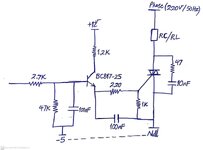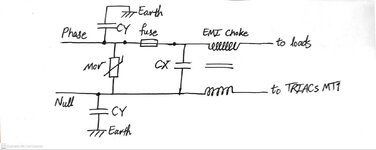Ario87
Newbie

Hi,
In a dishwasher machine main board we have used 107NN0 triac for controlling ac loads such as valves, pumps, dispenser, etc. In about 2 to 3 percent of products sold to customers, one of triacs that has a parallel RC equivalent load is half-burned (triac is short-circuited in one direction) when the machine gets plugged in. Here's the schematic of a single triac on mainboard. All 8 triacs have the same configuration. One triac has RC load and others have inductive load. Surprising point is that we couldn't reproduce the fault in lab under different test conditions such as Surge or EFT noise, input voltage connection in different angles of sine wave. We're glad if anyone can help us about this problem.
In a dishwasher machine main board we have used 107NN0 triac for controlling ac loads such as valves, pumps, dispenser, etc. In about 2 to 3 percent of products sold to customers, one of triacs that has a parallel RC equivalent load is half-burned (triac is short-circuited in one direction) when the machine gets plugged in. Here's the schematic of a single triac on mainboard. All 8 triacs have the same configuration. One triac has RC load and others have inductive load. Surprising point is that we couldn't reproduce the fault in lab under different test conditions such as Surge or EFT noise, input voltage connection in different angles of sine wave. We're glad if anyone can help us about this problem.




